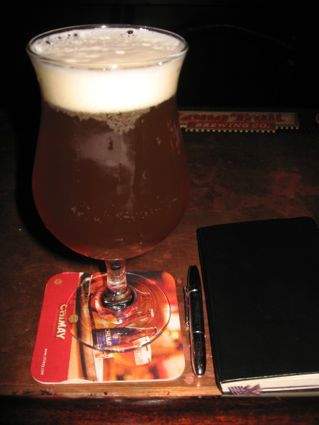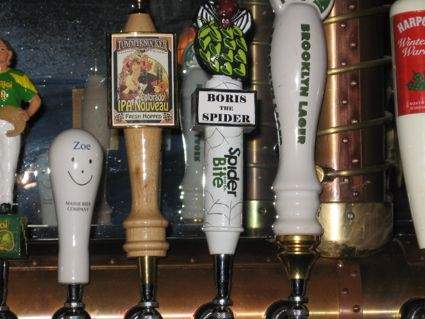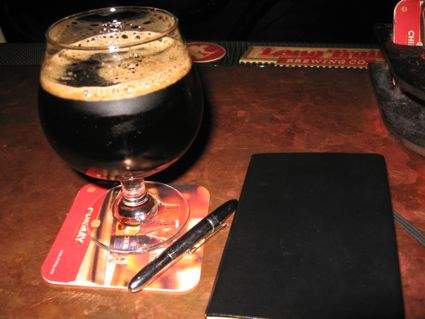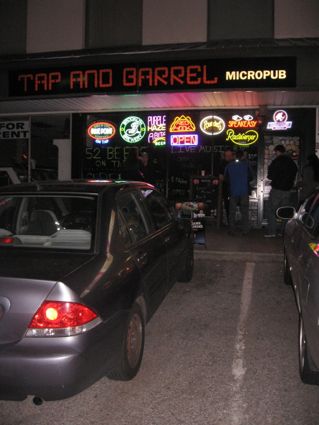Tap and Barrel Micropub (Smithtown, NY)
By Donavan Hall, Long Island Beer Correspondent

I had arrived at Tap & Barrel just a few minutes before Rich Thatcher, long enough to have studied the menu of 52 tap offerings — well, it was 51 that night. Nothing was on tap #42. I had asked the bartender if the absence of a beer on tap number 42 had any special significance. 42 is just one of those special numbers. Just saying “forty-two” can conjure up whole worlds, universes even, in the imagination. Locked inside that number are the deep mysteries of life, the universe, and everything. To contemplate that number is to seek after the meaning of it all. To penetrate the mystery is to taste the good life. And not having a beer on tap #42 just might be a sign that ultimate meaning is unattainable.
Or perhaps, there was a beer on tap #42 and the fact that it couldn’t be named was further evidence of this tap’s role as a gateway to the unknown.
I ordered a pint of Greenport Harbor’s Chinook Red. When Rich arrived, he glanced at the taps and ordered a glass of Spider Bite’s Boris the Spider Russian Imperial Stout. “How is it?” I asked. “Too cold,” he said. “I’ll let it warm up.”
Rich wears a couple of hats in the local beer scene. As president of the Long Island Beer and Malt Enthusiasts, a craft beer appreciation and brewing club with over 500 members, he commands an army of drinkers who have helped shape the craft beer culture on Long Island through their patronage of craft beer bars like Tap & Barrel. Rich is also craft beer salesman. He works for one of the Island’s largest beer distributorships and he represents a number of craft brands (such as Avery Brewing Company). So when Rich and I get together, he tells me all about the business side of things, and the games that some distributors play to influence what a beer bar puts on tap for its customers.
Even though I’m on a slow track into the beer business (on the beer production side) I will try to hold onto my outsider status as long as possible. The benefit of being an outsider is that my imagination is not inhibited by trivialities such as facts. You see, as someone who is ignorant of the realities of running a craft beer bar (or store or bottle shop) I am free to imagine ideal, beery Utopias where bar owners can put whatever beer on tap that they want.
So it’s a little annoying to me to hear Rich tell me, “No, Donavan, Tony has to deal with these specific distributors and sometimes the beer he wants just won’t make it to him for reasons that have to do with how the system works, or doesn’t work, depending on how you look at it.” Tony is Anthony Celentano, the owner of Tap & Barrel.
Rich already knows about my dream of Long Island becoming the nation’s craft beer Mecca. “I see a future for Long Island where there is peaceful coexistence between hundreds of nanobreweries, all supplying the craft beer bars within twenty miles of the most diverse selection of quality beers available.” In such a dream future, Tony would be able to get any beer style he wants directly from a local brewer. He would be the curator of magnificent collection of locally brewed craft beer.
Despite the limitations of the three-tier distribution system, Tony has done pretty well in selecting a line-up for his 52 taps that balances locally brewed craft beer with the more respected beers available from regional and national craft brewers.

After polishing off the satisfyingly hoppy Red Ale from Greenport Harbor, I wanted something else that was local. “What do you think, Rich?” I asked. “Is Southampton still local?” Rich just gave me a look. “You’re kidding, right?”
A tap just to the left of me promised Southampton Christmas Ale. Regardless of precisely where Southampton Christmas Ale is brewed, I turn a blind-eye and enjoy it each year at this time, during the holiday season.
Finding an excellent Bière de Garde isn’t easy. There are not many of them. Bière de Garde is a French-style, well northern French. The border in that part of the world has drifted back and forth over the centuries so northern France and southern Belgium share a lot of the same beer culture. Perhaps by some unspoken agreement France gets to claim Bière de Garde, Bière de Mars, Bière de Anything (?) as its own leaving the more ecclesiastical brews to the Trappists in Belgium — France, as ever, retaining its status as a secular state.
Another of my favorite (the favorite?) beer styles, Saison, appears to be in dispute. Sometimes a Saison is French, sometimes it’s Belgian. So the struggle over borderlines continues, but the modern battlefield is shaped by malt and yeast rather than by barbed wire. And that’s the better way I should think.
Of course it would not be at all appropriate to serve a Bière de Garde in a shaker pint (which would be the equivalent of presenting a fillet mignon in the bottom of a galvanized steel bucket). Our affable bartender presented my Southampton Christmas Ale in an elegant stemmed tulip glass, the reddish beer shaped into an attitude of jubilation by the narrow glass, and topped with a beige-tinted layer of lacy foam. (N.B. On a recent trip out to the Southampton Publick House I ordered a glass of the Christmas Ale and they served it in a shaker pint, so even at the source you aren’t guaranteed proper service.)

Bière de Garde is a nice style for winter drinking. At 7.2% ABV it’s right at the threshold of perceptible alcohol flavor that imparts what we beer geeks call “a warming effect.” In addition to being warming, the beer has a pleasant spicy character that comes from the hops. The hop variety used in this beer is called Strisslespalt and it’s rarely used in anything but French and Belgian-style beers. However, the head brewer at our not-yet-open brewery, Yuri, designed an “English” Ale hopped exclusively with Strisslespalt just to see how it would turn out. Our English-French-Belgian fusion beer spiced with Strisslespalt is on tap at my house. So when I plunge my nose into the tulip glass brimming with Southampton Christmas Ale, I’m greeted by familiar aromas.
My drinking plan was to end with a glass of the Spider Bite Boris the Spider Imperial Russian Stout. Rich was kind enough to share a sip from his glass once it had warmed a little. Boris is a ten percenter, that is, its ABV is up in the double digits. It’s warming, but in a subtle (possibly) dangerous way.

The bartender, quiet rightly, served Boris in a small snifter glass (probably only 8 ounces). The snifter, also on a stem, has a large bowl, but instead of flaring out at the top, it flares in. The idea behind the design of the snifter (as the name might suggest) is to concentrate the aroma of the beer and direct those delectable vapors to the drinker’s nose. It’s a good glass to use for aromatic beers. But it’s also the style of glass we beer drinkers sip strong beers from. Most highly alcoholic beer-styles (Barleywines and Imperial Anythings) will (should) be served in a snifter.
While I was enjoying the smooth, chocolate mocha Boris from my diminutive snifter, I related to Rich my thoughts about the difference between a multi-tap bar and a craft beer bar. Just a couple of weeks ago, I’d visited the Long Island Ale House and I had written an account of that visit for the New York Cork Report. Multi-tap bars (usually sports bars) will typically have a selection of craft beer along with industrially produced beers and major-brand imports. This is a good thing in general, but I have a few concerns.
The multi-tap bar, since it isn’t a craft beer bar, doesn’t treat the craft beer any differently than the industrial beer. So when you order a beer in a multi-tap bar, you are likely to get your Russian Imperial Stout in a frosty shaker pint. We beer geeks might snicker at this faux pas, but think about the beer newbie who is craft-curious and just making their first baby steps into the world of real beer. Not only is the beer served incorrectly, the fact that the newbie drinker (used to industrial light lager) will try to knock back his pint of Imperial Stout. It doesn’t taste like it’s overly alcoholic, so he orders another. Then it’s halftime and he gets up and tries to walk.
As a craft brewer and craft brewery owner, I’m connected to my beer. When I send a keg of beer out into the world, that beer is my representative. And I want to impress people. I want my beer to impress them. Putting my beer in a bar that is unable to present my beer the way I envision is a scary prospect. I don’t want my beer served in a frosty shaker pint because I know that it won’t taste the way I designed it to taste. Admittedly, this the the concern of the brewer. It’s not just a financial consideration, I know the work and time that went into making that glass of beer, and so I want to see that the beer gets to the drinker the way it was meant to be. Therefore, a proper craft beer bar with knowledgeable staff and an experienced cellarman will maximize the chance that my beer will be served appropriately and in the best condition.















“Then its half time and he gets up and tries to walk.” that quote would describe me on New Years Eve after pouring Gulden Draak into a pint glass at home.
Looks like i need to check out Tap and Barrel.
It’s worth a trip. At the moment they have a couple of Limited Releases from Blue Point, a White IPA (think Belgian Wit crossed with an IPA), and a Black IPA. Cheers!
I went to a “fancy” restaurant in Riverhead last week whose taps included Abita, Southampton, and PBR. I ordered the Southampton (I can’t remember the style now) and cringed as I watched the bartender take the tall pilsner glass out of the refrigerator to pour my beer. No surprisingly he didn’t take glasses out of the freezer for the red wine that was also coming to my table. Even when restaurants and bars “get” that craft beer is on the rise, they still insist on treating it as high priced Budwieser…